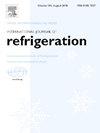Experimental study about spraying the condensate water on the performance of open refrigerated display cabinet
IF 3.5
2区 工程技术
Q1 ENGINEERING, MECHANICAL
International Journal of Refrigeration-revue Internationale Du Froid
Pub Date : 2025-03-10
DOI:10.1016/j.ijrefrig.2025.03.018
引用次数: 0
Abstract
Nowadays, the demand for open refrigerated display cabinets (ORDCs) is on the rise, accompanied by a growing urgency to address energy-related challenges. While the recycling of condensate water has been identified as a potential avenue to enhance ORDC performance, the subsequent management of this recycled condensate has garnered insufficient attention. To address this critical gap, this study delves into the influence of spraying condensate water and introduces the critical flowrate - the maximum flowrate at which all condensate water is entirely evaporated. The impact of some key factors, such as the flowrate of condensate water, the nozzle number, the spraying distance, and the ambient temperature and humidity, are experimentally discussed. Results show that, increasing the flowrate of condensate water enhances the ORDC performance until the optimal flowrate is achieved. The critical flowrate is inherently lower than the optimal flowrate. Increasing the nozzle number, spraying distance, and decreasing ambient temperature and humidity, could improve the ORDC performance, and the corresponding critical flowrate could be also increased. The critical flowrate is almost the same for different conditions. For the studied ORDC, the critical flowrate is 32.9 ml/min under which the coefficient of performance (COP), thermal entrainment factor (TEF), and the reduction of compressor power consumption (Q) could be improved by 51.1 %, 33.3 %, and 260.7 W, respectively, compared to that without spraying the condensate water.
求助全文
约1分钟内获得全文
求助全文
来源期刊
CiteScore
7.30
自引率
12.80%
发文量
363
审稿时长
3.7 months
期刊介绍:
The International Journal of Refrigeration is published for the International Institute of Refrigeration (IIR) by Elsevier. It is essential reading for all those wishing to keep abreast of research and industrial news in refrigeration, air conditioning and associated fields. This is particularly important in these times of rapid introduction of alternative refrigerants and the emergence of new technology. The journal has published special issues on alternative refrigerants and novel topics in the field of boiling, condensation, heat pumps, food refrigeration, carbon dioxide, ammonia, hydrocarbons, magnetic refrigeration at room temperature, sorptive cooling, phase change materials and slurries, ejector technology, compressors, and solar cooling.
As well as original research papers the International Journal of Refrigeration also includes review articles, papers presented at IIR conferences, short reports and letters describing preliminary results and experimental details, and letters to the Editor on recent areas of discussion and controversy. Other features include forthcoming events, conference reports and book reviews.
Papers are published in either English or French with the IIR news section in both languages.

 求助内容:
求助内容: 应助结果提醒方式:
应助结果提醒方式:


